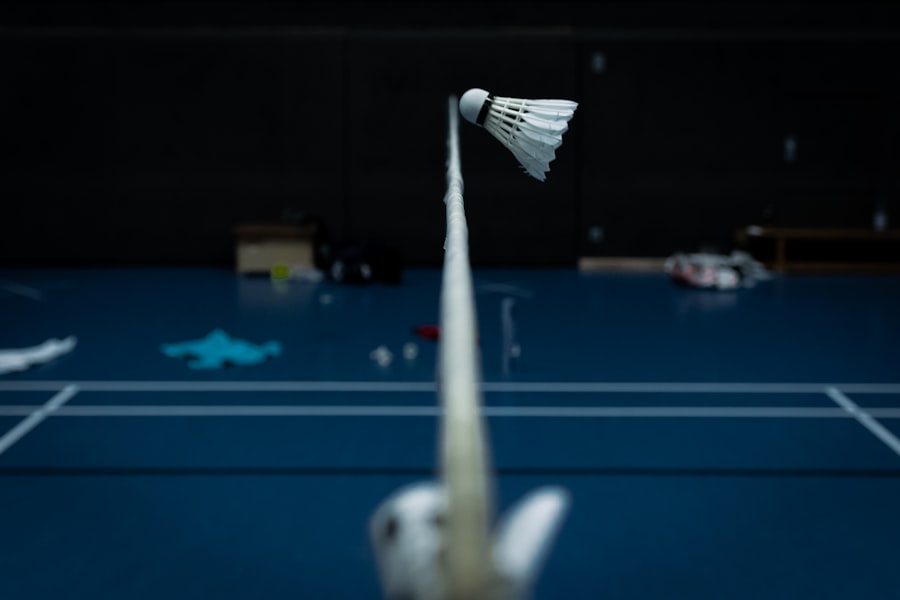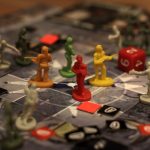Download links
How to install Mastering the Art of Badminton: Tips for Success APK?
1. Tap the downloaded Mastering the Art of Badminton: Tips for Success APK file.
2. Touch install.
3. Follow the steps on the screen.
Description
Badminton is a fast-paced racquet sport that has gained immense popularity worldwide, characterized by its unique blend of agility, strategy, and precision. The game is played either in singles or doubles format, with players using a shuttlecock, which is a feathered projectile, to score points by landing it in the opponent’s court. The objective is simple: to hit the shuttlecock over the net and into the opponent’s side of the court while preventing them from returning it.
The sport requires not only physical prowess but also a deep understanding of its rules and regulations, which govern everything from scoring to player conduct. At its core, badminton is played on a rectangular court divided by a net. The dimensions of the court vary slightly between singles and doubles play, with the latter utilizing a wider area.
Each match is typically played in a best-of-three games format, with players or teams needing to reach 21 points to win a game. The scoring system is based on rally scoring, meaning that a point is awarded on every serve, regardless of which side served. This system has made the game more dynamic and exciting, as players must remain vigilant and competitive throughout each rally.
Key Takeaways
- Badminton is a fast-paced racket sport played with a shuttlecock, and requires agility, speed, and precision.
- Proper footwork and movement are essential for success in badminton, including quick changes in direction and efficient court coverage.
- Mastering essential badminton strokes such as the clear, drop shot, smash, and drive is crucial for offensive and defensive play.
- Improving your serve and return in badminton involves mastering different types of serves and developing quick reflexes for returning shots.
- Enhancing your strategy and game plan in badminton involves understanding your opponent’s weaknesses and strengths, and adapting your play accordingly.
Developing Proper Footwork and Movement
Footwork is often regarded as one of the most critical components of badminton, as it directly influences a player’s ability to position themselves optimally for each shot. Effective footwork allows players to move swiftly around the court, enabling them to reach the shuttlecock in time and execute their strokes with precision. A solid foundation in footwork begins with mastering basic movements such as lunges, sidesteps, and quick pivots.
These movements not only enhance agility but also improve balance and coordination, which are essential for executing complex shots. To develop proper footwork, players should focus on maintaining a low center of gravity while moving. This can be achieved by bending the knees slightly and keeping the feet shoulder-width apart.
Practicing footwork drills, such as shadow badminton or ladder drills, can significantly enhance speed and reaction time. For instance, players can set up cones on the court and practice moving to each cone in various patterns, simulating real-game scenarios. Additionally, incorporating lateral movements into training routines helps players become more adept at covering the court efficiently.
By honing their footwork skills, players can ensure they are always in the best position to strike the shuttlecock effectively.
Mastering the Essential Badminton Strokes

A comprehensive understanding of badminton strokes is vital for any player aspiring to excel in the sport. The primary strokes include the forehand and backhand drives, clears, drops, smashes, and net shots. Each stroke serves a specific purpose and requires distinct techniques for execution.
For example, the forehand clear is executed by swinging the racquet from low to high, generating power while sending the shuttlecock deep into the opponent’s court. This stroke is particularly useful for pushing opponents back and creating space for subsequent attacks. On the other hand, mastering the backhand stroke can be challenging for many players due to its awkward positioning.
However, with practice, players can develop a strong backhand that allows them to respond effectively to shots directed towards their non-dominant side. The drop shot is another essential stroke that requires finesse; it involves gently tapping the shuttlecock just over the net to catch opponents off guard. Each stroke must be practiced repeatedly to build muscle memory and ensure consistency during matches.
By dedicating time to mastering these fundamental strokes, players can significantly enhance their overall gameplay and adaptability on the court.
Improving Your Serve and Return
| Metrics | Serve | Return |
|---|---|---|
| First Serve Percentage | 65% | 70% |
| Average Serve Speed | 120 mph | N/A |
| Points Won on 1st Serve | 80% | 65% |
| Points Won on 2nd Serve | 55% | 40% |
| Return Points Won | 35% | 45% |
The serve is one of the most critical aspects of badminton, as it sets the tone for each rally. A well-executed serve can put immediate pressure on opponents while providing an opportunity for the server to dictate play. There are various types of serves in badminton, including high serves, low serves, and flick serves.
High serves are typically used in singles play to push opponents back, while low serves are more common in doubles play to create quick exchanges at the net. Mastering these different serving techniques requires practice and an understanding of when to employ each type based on the opponent’s positioning. Equally important is the return of serve, which can often determine the outcome of a rally.
A strong return can put pressure on the server and shift momentum in favor of the returning player or team. Players should focus on reading their opponent’s serve and anticipating its trajectory to position themselves effectively for a return. Practicing various return techniques—such as aggressive drives or delicate net shots—can enhance a player’s ability to counter different types of serves.
By refining both serving and returning skills, players can gain a significant advantage in matches and create opportunities for scoring points.
Enhancing Your Strategy and Game Plan
Developing a strategic approach to badminton is essential for success at any level of play. A well-thought-out game plan allows players to exploit their strengths while capitalizing on their opponents’ weaknesses. One effective strategy involves varying shot placement and speed throughout a match to keep opponents guessing.
For instance, alternating between powerful smashes and delicate drop shots can disrupt an opponent’s rhythm and force them into making errors. Additionally, understanding court positioning is crucial for effective strategy implementation. Players should aim to control the center of the court, allowing them to cover more ground and respond quickly to their opponent’s shots.
In doubles play, communication and teamwork become paramount; partners must work together to create openings and defend against attacks. Analyzing opponents’ playing styles during matches can also provide valuable insights into how best to adjust one’s strategy mid-game. By continuously refining their strategic approach, players can enhance their overall performance and increase their chances of victory.
Building Endurance and Fitness for Badminton

Badminton is an intense sport that demands high levels of physical fitness and endurance from its players. The fast-paced nature of the game requires athletes to possess not only strength but also cardiovascular endurance to sustain prolonged rallies without succumbing to fatigue. Incorporating a well-rounded fitness regimen that includes aerobic exercises—such as running or cycling—can significantly improve stamina on the court.
Strength training is equally important for badminton players, as it enhances muscle power and reduces the risk of injury. Focusing on core strength through exercises like planks or medicine ball workouts can improve stability during dynamic movements on the court. Flexibility training through stretching or yoga can also aid in injury prevention while enhancing overall mobility.
By committing to a comprehensive fitness program that addresses endurance, strength, and flexibility, players can ensure they are physically prepared for the demands of competitive badminton.
Mental Preparation and Focus on the Court
Mental fortitude plays a pivotal role in badminton performance; players must cultivate focus and resilience to navigate the pressures of competition effectively. Developing a strong mental game involves techniques such as visualization, where players imagine themselves executing successful shots or winning crucial points during matches. This mental rehearsal can boost confidence and reduce anxiety before stepping onto the court.
Additionally, maintaining composure during high-stress situations is essential for optimal performance. Players should practice mindfulness techniques or breathing exercises to help manage nerves and maintain concentration throughout matches. Setting specific goals—both short-term and long-term—can also provide motivation and direction during training sessions and competitions.
By prioritizing mental preparation alongside physical training, players can enhance their overall performance and approach each match with confidence.
Fine-Tuning Your Skills through Practice and Training
Consistent practice is fundamental for any badminton player looking to improve their skills and performance levels. Structured training sessions that focus on specific areas—such as stroke technique, footwork drills, or match simulations—can lead to significant improvements over time. Players should seek feedback from coaches or experienced peers to identify areas for growth and refine their techniques accordingly.
Incorporating competitive play into training routines is also beneficial; participating in practice matches against various opponents exposes players to different playing styles and strategies. This experience helps develop adaptability on the court while reinforcing learned skills under pressure. Additionally, recording practice sessions or matches can provide valuable insights into performance trends over time, allowing players to track progress and make necessary adjustments in their training approach.
By committing to regular practice and embracing opportunities for growth, players can continually fine-tune their skills and elevate their game in badminton.
FAQs
What is badminton?
Badminton is a racquet sport played by either two opposing players (singles) or two opposing pairs (doubles), who take positions on opposite halves of a rectangular court divided by a net.
What equipment is used in badminton?
The primary equipment used in badminton includes a shuttlecock (also known as a birdie), badminton racquets, and a net. Players also wear appropriate footwear and may use accessories such as sweatbands and grip tape.
What are the basic rules of badminton?
The basic rules of badminton include serving diagonally, scoring points by landing the shuttlecock within the opponent’s court, and winning a match by winning two out of three games. Players must also adhere to rules regarding faults, such as hitting the shuttlecock out of bounds or touching the net.
What are the health benefits of playing badminton?
Playing badminton offers numerous health benefits, including improved cardiovascular fitness, agility, coordination, and flexibility. It also helps in burning calories, reducing the risk of chronic diseases, and improving mental well-being.
What are the different types of badminton shots?
Common badminton shots include the clear, drop shot, smash, drive, and net shot. Each shot serves a specific purpose and requires different techniques and strategies to execute effectively.
What are the different types of badminton tournaments?
Badminton tournaments can be categorized into international events such as the Olympics, World Championships, and BWF World Tour, as well as national and local competitions. These tournaments feature singles, doubles, and mixed doubles matches for both men and women.





